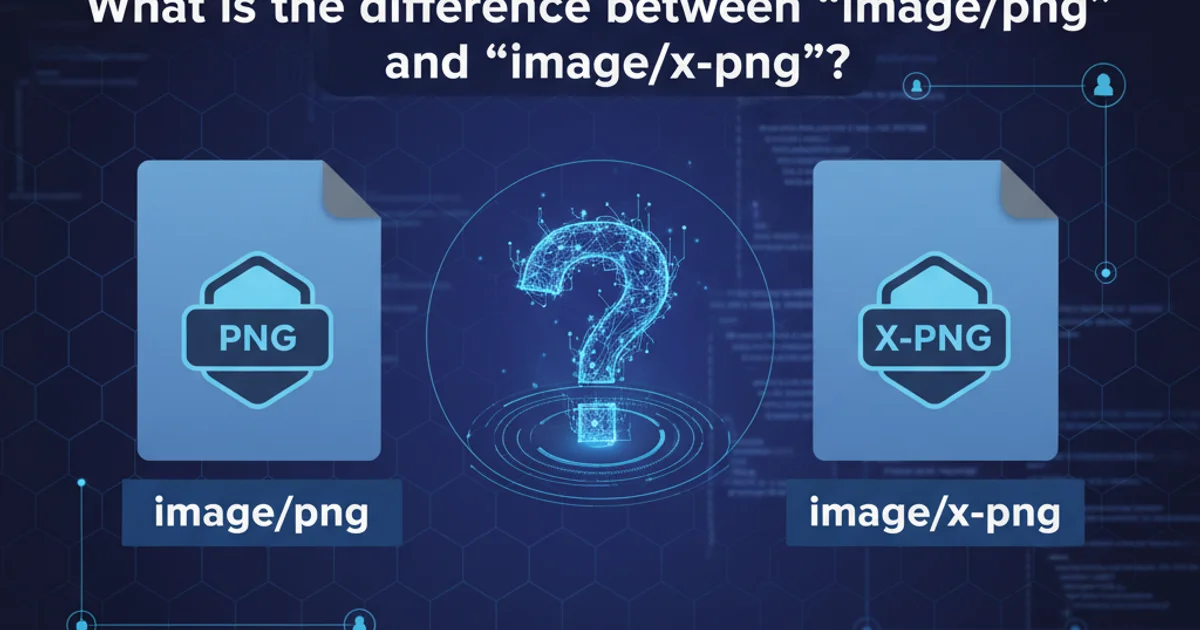What is the difference between "image/png" and "image/x-png"?
Categories:
Understanding 'image/png' vs. 'image/x-png' MIME Types

Explore the subtle but important differences between the standard 'image/png' and the deprecated 'image/x-png' MIME types, and learn why using the correct one matters for web compatibility and future-proofing.
In the world of web development and data transfer, MIME types (Multipurpose Internet Mail Extensions) are crucial for identifying the nature and format of a file. They tell browsers and applications how to handle specific content. When dealing with PNG images, you might encounter two seemingly similar MIME types: image/png and image/x-png. While they both refer to PNG files, their origins and implications for modern web practices are quite different.
The Standard: 'image/png'
The image/png MIME type is the official, standardized identifier for Portable Network Graphics (PNG) image files. It is registered with the Internet Assigned Numbers Authority (IANA), which is responsible for maintaining a registry of MIME types. This registration signifies that image/png is universally recognized and supported by web browsers, operating systems, and applications as the correct way to identify a PNG image.
When a server sends a file with the Content-Type: image/png header, the receiving client (e.g., a web browser) immediately understands that it's a standard PNG image and can render it appropriately. This ensures maximum compatibility and predictable behavior across different platforms and user agents.
The Experimental/Non-Standard: 'image/x-png'
The image/x-png MIME type, on the other hand, is a non-standard or experimental MIME type. The x- prefix historically indicated that a type was not officially registered with IANA and was often used for proprietary or experimental formats. In the early days of the web, before PNG became an official standard, some systems might have used image/x-png to identify PNG files.
However, once PNG was standardized and image/png was officially registered, the image/x-png variant became obsolete and deprecated. While some older systems or misconfigured servers might still send this MIME type, relying on it is problematic for several reasons:
- Compatibility Issues: Modern browsers and applications are primarily designed to recognize
image/png. While many might still gracefully handleimage/x-pngdue to backward compatibility efforts, there's no guarantee. Some strict parsers or newer systems might reject or misinterpret files with this non-standard type. - Deprecation: The
x-prefix is officially deprecated by IANA. New non-standard types should usevnd.(for vendor-specific) or be registered properly. - Future-Proofing: Using
image/x-pngmakes your content less robust and less future-proof. As web standards evolve, support for deprecated types can diminish.
flowchart TD
A["PNG File Created"] --> B{"Is MIME Type Standardized?"}
B -- Yes --> C["IANA Registers 'image/png'"]
B -- No --> D["Early/Experimental Use 'image/x-png'"]
C --> E["Web Server Sends 'image/png'"]
D --> F["Older/Misconfigured Server Sends 'image/x-png'"]
E --> G["Modern Browser: Renders PNG Correctly"]
F --> H["Modern Browser: May Render (Backward Comp.)"]
F --> I["Strict Parser: May Fail/Reject"]
G & H & I --> J["User Experience"]
style D fill:#f9f,stroke:#333,stroke-width:2px
style F fill:#f9f,stroke:#333,stroke-width:2px
style I fill:#f9f,stroke:#333,stroke-width:2pxFlowchart illustrating the lifecycle and implications of PNG MIME types.
image/png for all PNG files. This ensures maximum compatibility and adherence to current web standards.Why the Distinction Matters
The distinction between image/png and image/x-png highlights the importance of adhering to official standards in web development. While a browser might display an image sent with image/x-png today, there's no guarantee it will do so tomorrow, or that other applications will. Using the correct, standardized MIME type is a fundamental aspect of building interoperable and reliable web applications.
This principle extends beyond PNGs to all file types. Always consult IANA's official MIME type registry or reliable documentation to ensure you are using the most appropriate and widely supported MIME type for your content.
HTTP/1.1 200 OK
Content-Type: image/png
Content-Length: 12345
[PNG image data]
Example HTTP header for a correctly served PNG image.
HTTP/1.1 200 OK
Content-Type: image/x-png
Content-Length: 12345
[PNG image data]
Example HTTP header for a PNG image served with a deprecated MIME type (avoid this).
image/x-png in your server configurations or application code, it's a strong indicator that an update or correction is needed to align with modern web standards.